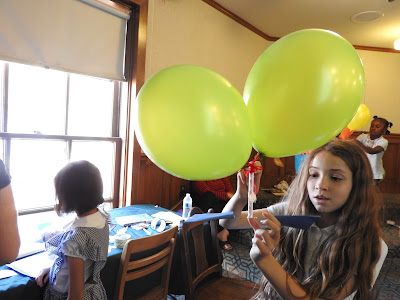Propeller Powered Balloon Helicopters - New and Improved Formula!
Last week kids came to Pasadena Library to learn about elastic energy and the Law of Conservation of Energy, and then build a helicopter that would rise up in the air at least briefly before coming down. We attached helium balloons to a homemade helicopter that runs on the elastic energy of a twisted-up rubber band, and since the apparatus itself is heavy enough, the whole thing generally floats gently down. (OK, some kids did have to add a weight in order to counteract the extreme lift of the helium.) Kids had a blast making their helicopters, even though it was not an easy project, and required a lot of tinkering and troubleshooting!
I did this program before at Pasadena Public Library, and shared it on my blog a few years ago. I'm sharing this year's experience because I think I learned some things that might have improved the project back then.
I first found the project in 2014 on curiositymachine.org. You may have to subscribe to get access to all their projects but they teach kids a lot about science and engineering with activities that are challenging but not expensive. You don't have to look hard for the materials used in these projects--they are mainly household materials. And on Wednesday, I actually found that one of the materials they suggested could be substituted easily for something much cheaper and more effective.
First I do a science presentation with the kids. Here are my slides:
I explained the Law of Conservation of Energy and we discussed some examples of kinetic energy, using that game I created a few years ago on Scratch:
https://scratch.mit.edu/projects/31671030/
Then we get into making the blades of our helicopter. I made two iterations of this project myself during the day, in order to get a strong feel for what troubleshooting issues may come up.
When trying my first one out, which was based on the Curiosity Machine website's instructions except for one change--a wooden skewer for a propeller base--I got frustrated that it stopped working after a few spins, and that it never spun very fast. It seems the rubber bands slowly wear down their ability to store elastic energy after several spins, and the wooden skewer seemed to generate too much friction. I switched to an unbent paperclip like in Curiosity Machine's original model. But even with the reduction in friction, my blades still weren't turning fast enough.
I took the plates off and found that the paperclip by itself would spin very fast. So I tried to make blades that would reduce the pull or drag on the paperclip. In the end, small, simple blades made from construction paper required the least amount of energy to spin. I could spin them and release them and watch my machine shoot up in the air!
I made additional adjustments to my model too, like taping the balloons down so that no elastic energy would get diverted onto the string. Believe me, if you don't secure the balloons tightly you'll end up with rapidly spinning balloons and dead propeller blades. It's the Law of Conservation of Energy--the energy gets converted and used up by the yarn!
So here's my final draft: smaller construction paper blades, and tightly secured balloons:
Another thing I did to make my final iteration of the project work was to tie a knot around the top of the rubber band above the straw motor casing with some yarn. That prevented the rubber band from trying to spin the wooden skewer holding the balloons.
Here's another video of me demonstrating my sample to the class:
This project is not easy! It requires patience and resilience. With time and work, most of the kids were able to get their helicopters going. Here, a kid shows us his finished balloon helicopter:
And this next kid had a really hard time with his, and sometimes the materials came apart. But he kept at it and got results! Personally those outcomes are my favorite because the kids learn that things don't always come easy, but that doesn't mean you give up--you have to develop a zest for tweaking it and trying again.
I was really lucky to have a volunteer, a library student I'm mentoring who is working on getting her master's degree, to help me. She gave me a hand with setup and cleanup, taking pictures and videos, passing out materials, and helping the kids troubleshoot. She also created our flyer for the program!
Thank you so much Jess for your help! And thank you to all the kids and parents who participated!

















Comments
Post a Comment